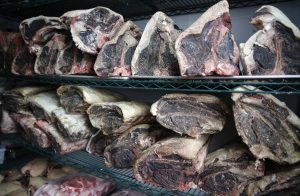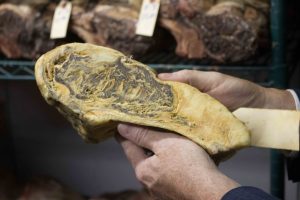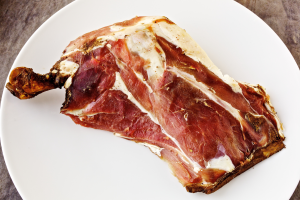

The advent of vacuum packaged wholesale cuts in the 1960’s was a new way of shipping and storing fresh meat. Prior to that harvested beef and lamb carcasses hung in coolers for an average of 7 to 10 days before moving into local retail stores. Up to a 2 week dry-aging period was/is sufficient time to adequately enhance meat tenderness; while inducing minor amounts of carcass dehydration, freshening trim loss, fat oxidation and meat protein biogenic amine formation. Further, leaving carcasses hang longer than a day or two is thought by some to stretch muscle fibers, to aid in meat tenderization. The advantages of vacuum packaging are: Sealing fresh meat away from microorganisms which are present all along the marketing & distribution chain; good harvest plant sanitation helps keep anaerobic bacteria from being sealed in with vac-packed meat cuts. Wet-aging (in vacuum bags) is as effective as dry-aging for meat tenderization purposes. Rail equipped cooler space requirements are greatly reduced at both the wholesale & retail level, trimmings and “end” carcass cuts (which won’t benefit from dry-aging for steak flavor development) can be separated from carcasses after about 2 days post-mortem. Harvest plant wholesale cut fabrication facilitates the gathering of large volumes of trimmings to sell to further processing plants, trimmings are shipped while still in excellent fresh condition (exterior, long, dry-aged trim is not usable for further processing due to dehydration, contamination & oxidized fat). Grinding “pre-chews” tough meat so there is no need at all to age beef trimmings used in most further processed item formulations. Retailers are able to buy the cuts that sell best in their regional markets. Loss of salable weight from product dehydration is significantly reduced. The need to freshen/face the exterior surface of cuts is lessened. And, the dry-aging of wholesale rib & loin cuts can still be practiced at the retail level (in shops or restaurants). There is apparently no reason for concern about fresh meat being in direct contact with shrunken vacuum packaging (packaging material residue left on meat), or else we should have heard about it by now. Boxed meat is considered to be a major factor in the consolidation of the meat industry that took place during the 1970’s & 80’s, but don’t forget that without plastic primary containers mere cardboard cartons would be largely inadequate. However, pre-vacuum packaging & pre-pump enhanced wholesale pork cuts were wrapped in laminated paper the day after slaughter and shipped in boxes.
Over a given time period both dry and wet (in vacuum bags) aging will produce about the same tenderization effect. Despite all the economic benefits that wet-aging has to offer, dry-aging is increasingly being used to obtain gourmet flavors and juicier end-products. When this art form is successfully carried out long time period dry-aging delivers a unique dinning experience that’s considered to be well worth wasting edible product, extra labor and prolonged facility usage. Practicing dry-aging “right” is combination of cooler temperature, relative humidity, air circulation and length of the aging period. Contrary to what is now often seen where people are bragging about their supper long aging times, there is an optimal length of time range that is wise to stay within. A thick layer of fat, on large cuts or carcasses helps protect valuable lean from exposure, as meat tissues break down and partially dehydrates during the aging process. As fat and lean go through this controlled open-air breakdown some potentially detrimental chemical substances are formed. Biogenic amines can develop when certain types of bacteria react with amino acids; that have been freed as animal proteins break down. Furthermore, a wide variety of bacteria are present throughout dry-aging. A hive producing allergic reaction to histamine is an example of what can happen when a person’s body becomes overloaded with biogenic amines. Fat oxidation occurs in both during dry-aging & dry-sausage ripening. Oxidation can cause the formation of aldehydes, ketones, alkanes, alkenes, alcohols, esters, acids and hydrocarbons. Therefore, there definitely will be some unique flavors formed from dry-aging. Another type of meat flavor change is caused by the concentration of flavors as dry-aging meat shrinks from partial dehydration. In research studies using the same meat cut for both dry and wet aging, increased juiciness was routinely observed in dry-aged beef. That juiciness increase is likely caused by the concentration of marbling as lean dehydrates.
The terms grass-finished and grass-fed beef are most often considered to be synonymous and all beef cattle are fed forage diets the majority of their lives. In forage beef production enterprises, where cattle are fed to an older market age than those that are grain-finished, stronger beef flavors are to be expected. Also, grass-finished market cattle would be more likely to benefit from either dry or wet-aging in order to obtain an acceptable level of tenderness. However the further concentration of already strong flavors, via partial dehydration, would logically seem to be ill advised for mainstream tastes. Modern day American chef’s widespread preference for grass-fed beef, practicing in-house charcuterie and just about all other things European might come from their love of Julia Child. Counterintuitive to current mainstream culinary thinking, grain-finished beef is younger (more likely to be tender), most often displays higher marbling degrees and possesses a milder flavor (both increased age & forage finishing diets increase strong meat flavors). And, the practicing of labor & facility intensive, pre-refrigeration technology charcuterie will eventually produces end-items that may not be advisable to consume on a regular basis. Proteins and fat in dry-cured or ripened fermented sausage products also break down during long holding periods. Most economically important, both grass-fed and dry-aging can prompt high-end consumers to believe that they are buying something truly gourmet/special; that can later be boasted about.
The dry-aging of beef hindquarters has less exposed surface per unit of mass than does the dry-aging the smaller lamb cuts pictured below it. The lamb does however carry plenty of fat cover so the loss of lean will be limited when fabricated into chops. And, already small lamb chops will be even smaller due to partial dehydration. Normal lamb flavor is often considered to be strong; dry-aging may tend to make it more so. Perhaps long dry-aging could cause the development of more cheese-like flavors that mask concentrated lamb or mutton odors.

Lack of tenderness is not a deficiency in market age pork carcasses. So any dry-aging of pork would seem to be for flavor development and a firmer textured chop. Lamb fat is the hardest (most saturated), followed by beef fat then pork fat. Pork fat firmness is greatly influenced by the saturation of fat in a hogs diet. A corn based diet will yield harder carcass fat than the feeding of soy, peanuts or human food waste. Soft pork fat causes a consumer acceptance issue. Grass-finished beef fat is widely touted as being less saturated than the fat from grain-finished market cattle, but measurable differences are minute. The softer a fat type, the faster it is expected to oxidize.
Individual steaks are too small because there is way too much exposed lean to try and dry-age. When I see people trying to dry-age individual steaks, I begin thinking that dry-aging has now become a widespread American fad that’s coexisting with grass-fed (and not necessarily grass-finished) beef.

I so love the insight you provide. Keep up the great work.
Thank you Dmomita. I like to teach and learn about the world-wide meat industry.
Hello i am director of Ecofarm in Slovakia. Eco farm Važec is a certified ECO farm in northern Slovakia.
We produce delicious organic cheeses, traditional Slovak bryndza, parenice, cheese strings, broth and whey, made from milk from organically reared cows and sheep.
We would like to build new aging meat. We cant find any informations on our websites in slovakia so we would like to ask you for more information and help with it. thanks in advance.
Mgr. Petra Maľaková
riaditeľ PD Važec
Tel: +421 908 995 747
Mail: [email protected]
http://www.ekofarmavazec.sk
http://www.facebook.com/pdvazec
Good to hear from you Petra,
I take it that your company would be interested in aging the carcasses of young steers or wethers; that are generated as part of dairy production. There’s no benefit from aging carcasses from culled milking stock because they are tougher/will most often be ground. Microorganisms picked up on carcass exteriors during dry-aging will quickly contaminate throughout product when ground. For basic information about red meat aging, and much more, I recommend The Meat We Eat text book.